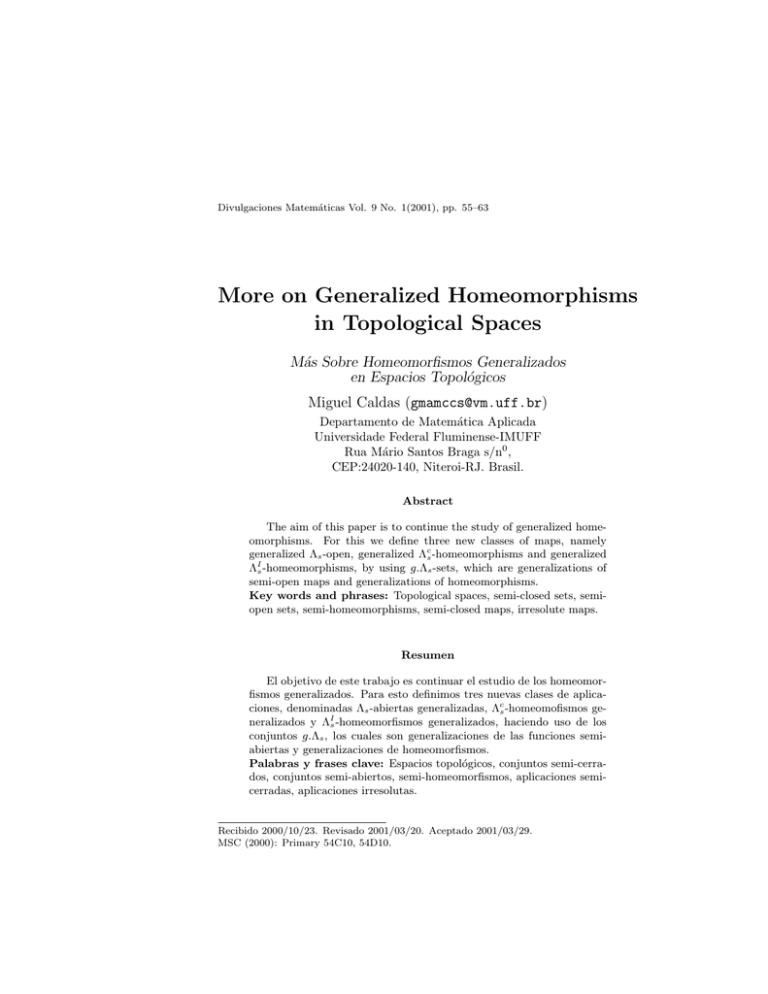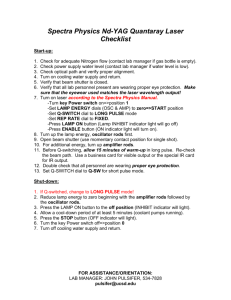More on Generalized Homeomorphisms in Topological Spaces M´as Sobre Homeomorfismos Generalizados
advertisement

Divulgaciones Matemáticas Vol. 9 No. 1(2001), pp. 55–63
More on Generalized Homeomorphisms
in Topological Spaces
Más Sobre Homeomorfismos Generalizados
en Espacios Topológicos
Miguel Caldas (gmamccs@vm.uff.br)
Departamento de Matemática Aplicada
Universidade Federal Fluminense-IMUFF
Rua Mário Santos Braga s/n0 ,
CEP:24020-140, Niteroi-RJ. Brasil.
Abstract
The aim of this paper is to continue the study of generalized homeomorphisms. For this we define three new classes of maps, namely
generalized Λs -open, generalized Λcs -homeomorphisms and generalized
ΛIs -homeomorphisms, by using g.Λs -sets, which are generalizations of
semi-open maps and generalizations of homeomorphisms.
Key words and phrases: Topological spaces, semi-closed sets, semiopen sets, semi-homeomorphisms, semi-closed maps, irresolute maps.
Resumen
El objetivo de este trabajo es continuar el estudio de los homeomorfismos generalizados. Para esto definimos tres nuevas clases de aplicaciones, denominadas Λs -abiertas generalizadas, Λcs -homeomofismos generalizados y ΛIs -homeomorfismos generalizados, haciendo uso de los
conjuntos g.Λs , los cuales son generalizaciones de las funciones semiabiertas y generalizaciones de homeomorfismos.
Palabras y frases clave: Espacios topológicos, conjuntos semi-cerrados, conjuntos semi-abiertos, semi-homeomorfismos, aplicaciones semicerradas, aplicaciones irresolutas.
Recibido 2000/10/23. Revisado 2001/03/20. Aceptado 2001/03/29.
MSC (2000): Primary 54C10, 54D10.
56
1
Miguel Caldas
Introduction
Recently in 1998, as an analogy of Maki [10], Caldas and Dontchev [5] introduced the Λs -sets (resp. Vs -sets) which are intersections of semi-open (resp.
union of semi-closed) sets. In this paper we shall introduce three classes of
maps called generalized Λs -open, generalized Λcs -homeomorphisms and generalized ΛIs -homeomorphisms, which are generalizations of semi-open maps,
generalizations of homeomorphisms, semi-homeomorphisms due to Biswas [2]
and semi-homeomorphisms due to Crossley and Hildebrand [7] and we investigate some properties of generalized Λcs -homeomorphisms and generalized
ΛIs -homeomorphisms from the quotient space to other spaces.
Throughout this paper we adopt the notations and terminology of [10],
[5] and [6] and the following conventions: (X, τ ), (Y, σ) and (Z, γ) (or simply
X, Y and Z) will always denote topological spaces on which no separation
axioms are assumed, unless explicitly stated.
2
Preliminaries
A subset A of a topological space (X, τ ) is said to be semi-open [9] if for
some open set O, O ⊆ A ⊆ Cl(O), where Cl(O) denotes the closure of O in
(X, τ ). The complement Ac or X − A of a semi-open set A is called semiclosed [3]. The family of all semi-open (resp. semi-closed) sets in (X, τ ) is
denoted by SO(X, τ ) (resp. SC(X, τ )). The intersection of all semi-closed
sets containing A is called the semi-closure of A [3] and is denoted by sCl(A).
A map f : (X, τ ) → (Y, σ) is said to be semi-continuous [9] (resp. irresolute
[7]) if for every A²σ (resp. A²SO(Y, σ)), f −1 (A)²SO(X, τ ); equivalently, f
is semi-continuous (resp. irresolute) if and only if, for every closed set A
(resp. semi-closed set A) of (Y, σ), f −1 (A)²SC(X, τ ). f is pre-semi-closed
[7] (resp. pre-semi-open [1], resp. semi-open [11]) if f (A)² SC(Y, σ) (resp.
f (A)² SO(Y, σ)) for every A²SC(X, τ ) (resp. A²SO(X, τ ), resp. A²τ ). f is a
semi-homeomorphism (B) [2] if f is bijective, continuous and semi-open. f is a
semi-homeomorphism (C.H) [7] if f is bijective, irresolute and pre-semi-open.
Before entering into our work we recall the following definitions and propositions, due to Caldas and Dontchev [5].
Definition 1. Let B be a subset of a topological space (X, τ ). B is T
called
a Λs -set (resp. Vs -set) [5], if B = S
B Λs (resp. B = B Vs ), where B Λs = {O :
O ⊇ B, O²SO(X, τ )} and B Vs = {F : F ⊆ B, F c ²SO(X, τ )}.
Definition 2. In a topological space (X, τ ), a subset B is called
Divulgaciones Matemáticas Vol. 9 No. 1 (2001), pp. 55–63
More on Generalized Homeomorphisms in Topological Spaces
57
(i) generalized Λs -set (written as g.Λs -set) of (X, τ ) [5], if B Λs ⊆ F whenever B ⊆ F and F ²SC(X, τ ).
(ii) generalized Vs -set (written as g.Vs -set) of (X, τ ) [5], if B c is a g.Λs -set
of (X, τ ).
Remark 2.1. From Definitions 1, 2 and [5] (Propositions 2.1, 2.2), we have
the following implications, none of which is reversible:
Open sets →Semi-open sets→ Λs -sets→ g.Λs -sets , and
Closed sets→ Semi-closed sets→ Vs -sets→ g.Vs -sets
Definition 3. (i) A map f : (X, τ ) → (Y, σ) is called generalized Λs continuous (written as g.Λs -continuous) [6] if f −1 (A) is a g.Λs -set in
(X, τ ) for every open set A of (Y, σ).
(ii) A map f : (X, τ ) → (Y, σ) is called generalized Λs -irresolute (written as
g.Λs -irresolute) [6] if f −1 (A) is a g.Λs -set in (X, τ ) for every g.Λs -set of
(Y, σ).
(iii) A map f : (X, τ ) → (Y, σ) is called generalized Vs -closed (written as
g.Vs -closed) [6] if for each closed set F of X, f (F ) is a g.Vs -set.
3
G.Λs -open maps and g.Λs -homeomorphisms
In this section we introduce the concepts of generalized Λs -open maps, generalized Λcs -homeomorphisms and generalized ΛIs -homeomorphisms and we study
some of their properties.
Definition 4. A map f : (X, τ ) → (Y, σ) is called generalized Λs -open (written as g.Λs -open) if for each open set A of X, f (A) is a g.Λs -set.
Obviously every semi-open map is g.Λs -open. The converse is not always
true, as the following example shows.
Example 3.1. Let X = {a, b, c}, Y = {a, b, c, d}, τ = {∅, {b, c}, X} and σ =
{∅, {c, d}, Y }. Let f : (X, τ ) → (Y, σ) be a map defined by f (a) = a, f (b) = b
and f (c) = d. Then, for X which is open in (X, τ ), f (X) = {a, b, d} is not
a semi-open set of Y . Hence f is not a semi-open map. However, f is a
g.Λs -open map.
We consider now some composition properties in terms of g.Λs -sets.
Theorem 3.2. Let f : (X, τ ) → (Y, σ), g : (Y, σ) → (Z, γ) be two maps such
that g ◦ f : (X, τ ) → (Z, γ) is a g.Λs -open map. Then
Divulgaciones Matemáticas Vol. 9 No. 1 (2001), pp. 55–63
58
Miguel Caldas
(i) g is g.Λs -open, if f is continuous and surjective.
(ii) f is g.Λs -open, if g is irresolute, pre-semi-closed and bijective.
Proof. (i) Let A be an open set in Y . Since f −1 (A) is open in X, (g ◦
f )(f −1 (A)) is a g.Λs -set in Z and hence g(A) is g.Λs -set in Z. This implies
that g is a g.Λs -open map.
(ii) Let A be an open set in X. Then (g ◦ f )(A) is a g.Λs -set in (Z, γ). Since g
is irresolute, pre-semi-closed and bijective, g −1 (g ◦f )(A) is a g.Λs -set in (Y, σ).
Really, suppose that (g ◦ f )(A) = B and g −1 (B) ⊆ F where F is semi-closed
in (Y, σ). Therefore B ⊆ g(F ) holds and g(F ) is semi-closed, because g is presemi-closed. Since B is (g ◦ f )(A), B Λs ⊆ g(F ) and g −1 (B Λs ) ⊆ F . Hence,
since g is irresolute, we have (g −1 (B))Λs ⊆ g −1 (B Λs ) ⊆ F . Thus g −1 (B) =
g −1 (g ◦ f )(A) is a g.Λs -set in (Y, σ). Since g is injective, f (A) = g −1 (g ◦ f )(A)
is g.Λs -set in Y . Therefore f is g.Λs -open.
Remark 3.3. A bijection f : (X, τ ) → (Y, σ) is pre-semi-open if and only if f
is pre-semi-closed.
Theorem 3.4. (i) If f : (X, τ ) → (Y, σ) is a g.Λs -open map and g : (Y, σ) →
(Z, γ) is bijective, irresolute and pre-semi-closed, then g ◦ f : (X, τ ) → (Z, γ)
is a g.Λs -open map.
(ii) If f : (X, τ ) → (Y, σ) is an open map and g : (Y, σ) → (Z, γ) is a g.Λs open map, then g ◦ f : (X, τ ) → (Z, γ) is a g.Λs -open map.
Proof. (i) Let A be an arbitrary open set in (X, τ ). Then f (A) is a g.Λs -set
in (Y, σ) because f is g.Λs -open. Since g is bijective, irresolute and pre-semiclosed (g ◦ f )(A) = g(f (A)) is g.Λs -open. Really. Let g(f (A) ⊆ F where
F is any semi-closed set in (Z, γ). Then f (A) ⊆ g −1 (F ) holds and g −1 (F )
is semi-closed because g is irresolute. Since g is pre-semi-open (Remark 3.3)
(g(f (A)))Λs ⊆ g((f (A))Λs ) ⊆ F . Hence g(f (A)) is g.Λs -set in (Z, γ). Thus
g ◦ f is g.Λs -open.
(ii) The proof follows immediately from the definitions.
Definition 5. A bijection f : (X, τ ) → (Y, σ) is called a generalized Λcs homeomorphism (written g.Λcs -homeomorphism) if f is both g.Λs -continuous
and g.Λs -open.
In order to obtain an alternative description of the g.Λcs -homeomorphisms,
we first prove the following three theorems which are in [6].
Theorem 3.5. Let f : (X, τ ) → (Y, σ) be g.Λs -irresolute. Then f is g.Λs continuous, but not conversely.
Divulgaciones Matemáticas Vol. 9 No. 1 (2001), pp. 55–63
More on Generalized Homeomorphisms in Topological Spaces
59
Proof. Since every open set is semi-open and every semi-open set is g.Λs -set
(Remark 2.1) it is proved that f is g.Λs -continuous.
The converse needs not be true, as seen from the following example.
Example 3.6. Let X = Y = {a, b, c}, τ = {∅, {a}, {b}, {a, b}, {a, c}, X} and
σ = {∅, {a, b}, Y }. The identity map f : (X, τ ) → (Y, σ) is g.Λs -continuous
but it is not g.Λs -irresolute, since for the g.Λs -set {b, c} of (Y, σ) the inverse
image f −1 ({b, c}) = {b, c} is not a g.Λs -set of (X, τ ).
Theorem 3.7. A map f : (X, τ ) → (Y, σ) is g.Λs -irresolute (resp. g.Λs continuous) if and only if, for every g.Vs -set A (resp. closed set A) of (Y, σ)
the inverse image f −1 (A) is a g.Vs -set of (X, τ ).
Proof. Necessity: If f : (X, τ ) → (Y, σ) is g.Λs -irresolute, then every g.Λs set B of (Y, σ), f −1 (B) is g.Λs -set in (X, τ ). If A is any g.Vs -set of (Y, σ),
then Ac is a g.Λs -set (Definition 2(ii)). Thus f −1 (Ac ) is a g.Λs -set, but
f −1 (Ac ) = (f −1 (A))c so that f −1 (A) is a g.Vs -set.
Sufficiency: If, for all g.Vs -set A of (Y, σ)f −1 (A) is a g.Vs -set in (X, τ ), then
if B is any g.Λs -set of (Y, σ) then B c is a g.Vs -set. Also f −1 (B c ) = (f −1 (B))c
is a g.Vs -set. Thus f −1 (B) is a g.Λs -set.
In a similar way we prove the case g.Λs -continuous.
Theorem 3.8. If a map f : (X, τ ) → (Y, σ) is bijective irresolute and presemi-closed, then
(i) for every g.Λs -set B of (Y, σ), f −1 (B) is a g.Λs -set of (X, τ ) (i.e., f is
g.Λs -irresolute).
(ii) for every g.Λs -set A of (X, τ ), f (A) is a g.Λs -set of (Y, σ) (i.e., f is
g.Λs -preopen).
Proof. (i) Let B be a g.Λs -set of (Y, σ). Suppose that f −1 (B) ⊆ F where F
is semi-closed in (X, τ ). Therefore B ⊆ f (F ) holds and f (F ) is semi-closed,
because f is pre-semi-closed. Since B is a g.Λs -set, B Λs ⊆ f (F ), and hence
f −1 (B Λs ) ⊆ F . Therefore we have (f −1 (B))Λs ⊆ f −1 (B Λs ) ⊆ F . Hence
f −1 (B) is a g.Λs -set in (X, τ ).
(ii) Let A be a g.Λs -set of (X, τ ). Let f (A) ⊆ F where F is any semi-closed
set in (Y, σ). Then A ⊆ f −1 (F ) holds and f −1 (F ) is semi-closed because f is
irresolute. Since f is pre-semi-open , (f (A))Λs ⊆ f (AΛs ) ⊆ F . Hence f (A) is
a g.Λs -set in (Y, σ).
Divulgaciones Matemáticas Vol. 9 No. 1 (2001), pp. 55–63
60
Miguel Caldas
Corollary 3.9. If a map f : (X, τ ) → (Y, σ) is bijective, irresolute and presemi-closed, then:
(i) for every g.Vs -set B of (Y, σ), f −1 (B) is a g.Vs -set of (Y, σ), and
(ii) for every g.Vs -set A of (X, τ ), f (A) is a g.Vs -set of (Y, σ).
Proposition 3.10. Every semi-homeomorphism (B) and semi-homeomorphism (C.H) is a g.Λcs -homeomorphism.
Proof. It is proved from the definitions and Theorem 3.8.
The converse of Proposition 3.10 is not true as seen from the following
examples.
Example 3.11.
g.Λcs -homeomorphisms need not be semi-homeomorphisms (B).
Let X = Y = {a, b, c}, τ = {∅, {a}, X} and σ = {∅, {b}, {a, b}, Y }. Then
the g.Λs -sets of (X, τ ) are ∅, X, {a}, {a, b}, {a, c} and the g.Λs -sets of (Y, σ)
are ∅, Y , {b}, {a, b}, {b, c}. Let f be a map from (X, τ ) to (Y, σ) defined
by f (a) = b, f (b) = a and f (c) = c. Here f is a g.Λcs -homeomorphism from
(X, τ ) to (Y, σ). However f is not a semi-homeomorphism (B), since f is not
continuous.
Example 3.12.
g.Λcs -homeomorphisms need not be semi-homeomorphisms (C.H).
Let X = {a, b, c} and τ = {∅, {a}, {b, c}, X}. Let f : (X, τ ) → (X, τ ) be a
bijection defined by f (a) = b, f (b) = a and f (c) = c. Since f is not irresolute
f is not a semi-homeomorphism (C.H). However, f is a g.Λcs -homeomorphism.
We characterize g.Λcs -homeomorphism and g.Λs -open maps. The proofs
are obvious and hence omitted.
Proposition 3.13. For any bijection f : (X, τ ) → (Y, σ) the following statements are equivalent.
(i) Its inverse map f −1 : (Y, σ) → (X, τ ) is g.Λs -continuous.
(ii) f is g.Λs -open.
(iii) f is g.Vs -closed.
Proposition 3.14. Let f : (X, τ ) → (Y, σ) be a bijective and g.Λs -continuous
map. Then the following statements are equivalent.
(i) f is a g.Λs -open map.
(ii) f is a g.Λcs -homeomorphism.
(iii) f is a g.Vs -closed map.
Now we introduce a class of maps which are included in the class of g.Λcs homeomorphisms and includes the class de homeomorphisms. Moreover, this
class of maps is closed under the composition of maps.
Divulgaciones Matemáticas Vol. 9 No. 1 (2001), pp. 55–63
More on Generalized Homeomorphisms in Topological Spaces
61
Definition 6. A bijection f : (X, τ ) → (Y, σ) is said to be a generalized ΛIs homeomorphism (written g.ΛIs -homeomorphism) if both f and f −1 preserve
g.Λs -sets, i.e., if both f and f −1 are g.Λs -irresolute. We say that two spaces
(X, τ ) and (Y, σ) are g.ΛIs -homeomorphic if there exists a ΛIs -homeomorphism
from (X, τ ) in (Y, σ).
Remark 3.15. Every semi-homeomorphism (C.H) is a g.ΛIs -homeomorphism
by (Theorem 3.8). Every g.ΛIs -homeomorphism is a g.Λcs -homeomorphism.
The converses are not true from the following examples.
Example 3.16.
g.ΛIs -homeomorphisms need not be semi-homeomorphisms (C.H).
Let X = {a, b, c} and τ = {∅, {a}, {b, c}, X}. Then the g.Λs -sets of (X, τ ) are
∅, {a}, {b}, {c}, {a, b}, {a, c}, {b, c} and X. Let f : (X, τ ) → (X, τ ) be a map
defined by f (a) = b, f (b) = a, f (c) = c. Here f is a g.ΛIs -homeomorphism.
However f is not a semi-homeomorphism (CH), since it is not irresolute.
Example 3.17.
g.Λcs -homeomorphisms need not be g.ΛIs -homeomorphisms.
Let X = Y = {a, b, c}, τ = {∅, {a}, {b}, {a, b}, {a, c}, X} and σ = {∅, {a, b}, Y }.
The identity map f : (X, τ ) → (Y, σ) is not a g.ΛIs -homeomorphism since for
the g.Λs -set {b, c} of (Y, σ), the inverse image f −1 ({b, c}) = {b, c} is not
a g.Λs -set of (X, τ ), i.e., f is not g.Λs -irresolute (and so it is not a semihomeomorphism (C.H)). However f is a g.Λcs -homeomorphism.
Remark 3.18. From the propositions, examples and remarks above, we have
the following diagram of implications.
semi-homeom. (B)
→
6←
g.Λcs -homeom.
6↑ 6 ↓
%6.
6↓↑
semi-homeom. (C.H)
6←
→
g.ΛIs -homeom.
%6.
homeomorphism
&6-
4
Additional Properties.
Definition 7. A subset B of a topological space (X, τ ) is said to be g.Λs compact relative to S
X, if for every cover {Ai : i ∈ Ω} of B by g.Λs -subsets
of (X, τ ), i.e., B ⊂ {Ai : i ∈ Ω} where Ai (i ∈ Ω) are g.Λs -sets in (X, τ ),
Divulgaciones Matemáticas Vol. 9 No. 1 (2001), pp. 55–63
62
Miguel Caldas
S
there exists a finite subset Ωo of Ω such that B ⊂ {Ai : i ∈ Ωo }. If X is
g.Λs -compact relative to X, (X, τ ) is said to be a g.Λs -compact space.
Proposition 4.1. Every g.Vs -set of a g.Λs -compact space (X, τ ) is g.Λs compact relative to X.
Since the proof is similar to the sg-compactnees (see [4],Theorem 4.1), it
is omitted.
Proposition 4.2. Let f : (X, τ ) → (Y, σ) be a map and let B be a g.Λs compact set relative to (X, τ ). Then,
(i) If f is g.Λs -continuous, then f (B) is compact in (Y, σ).
(ii) If f is g.Λs -irresolute, then f (B) is g.Λs -compact relative to Y .
Proof. (i) LetS{Ui : i ∈ Ω} be any collection
of open subsets of (Y, σ) such
S
that f (B) ⊂ {Ui : i ∈ Ω}. Then B ⊂ {fS−1 (Ui ) : i ∈ Ω} holds and there
exists a finite subset Ωo of Ω such that B ⊂ {f −1 (Ui ) : i ∈ Ωo } which shows
that f (B) is compact in (Y, σ).
(ii) Analogous to (i).
Acknowledgement
The author is very grateful to the referee for his observations on this paper.
References
[1] Anderson D. R., Jensen, J. A. Semi-Continuity on Topological Spaces,
Atti Accad. Naz. Lincei Rend. Cl. Sci. Fis. Mat. Natur. 42(1967), 782–
783.
[2] Biswas, N. On some Mappings in Topological Spaces, Bull. Calcutta
Math. Soc. 61(1969), 127–135.
[3] Biswas, N. On Characterization of Semi-Continuous Function, Atti Accad. Naz. Lincei Rend. Cl. Sci. Fis. Mat. Natur., 48(1970), 399–402.
[4] Caldas, M. Semi-Generalized Continuous Maps in Topological Spaces,
Portugaliae Math., 52(1995), 399–407.
[5] Caldas, M., Dontchev, J. G.Λs -sets and G.Vs -sets, Mem. Fac. Sci. Kochi
Univ. (Math.), 21(2000), 21–30.
Divulgaciones Matemáticas Vol. 9 No. 1 (2001), pp. 55–63
More on Generalized Homeomorphisms in Topological Spaces
63
[6] Caldas, M. On Maps and Generalized Λs -sets, East-West J. Math.,
2(2000), 181–190.
[7] Crossley, G., Hildebrand, S. K. Semi-Topological Properties, Fund. Math.,
74(1972), 233–254.
[8] Devi, R., Balachandran, K., Maki, H. Semi-Generalized Homeomorphisms and Generalized Semi-Homeomorphisms in Topological Spaces,
Indian J. Pure Appl. Math., 26(1995), 275–284.
[9] Levine, N. Semi-open Sets and Semi-Continuity in Topological Spaces,
Amer. Math. Monthly, 70(1963), 36–41.
[10] Maki, H. Generalized Λ-sets and the Associeted Closure Operator, the
Special Issue in Commemoration of Prof. Kazusada IKEDA’s Retirement,
(1986), 139–146.
[11] Noiri, T. A Generalization of Closed Mapping, Atti Accad. Naz. Lincei
Rend. Cl. Sci. Fis. Mat. Natur. 54(1973), 412–415.
Divulgaciones Matemáticas Vol. 9 No. 1 (2001), pp. 55–63







